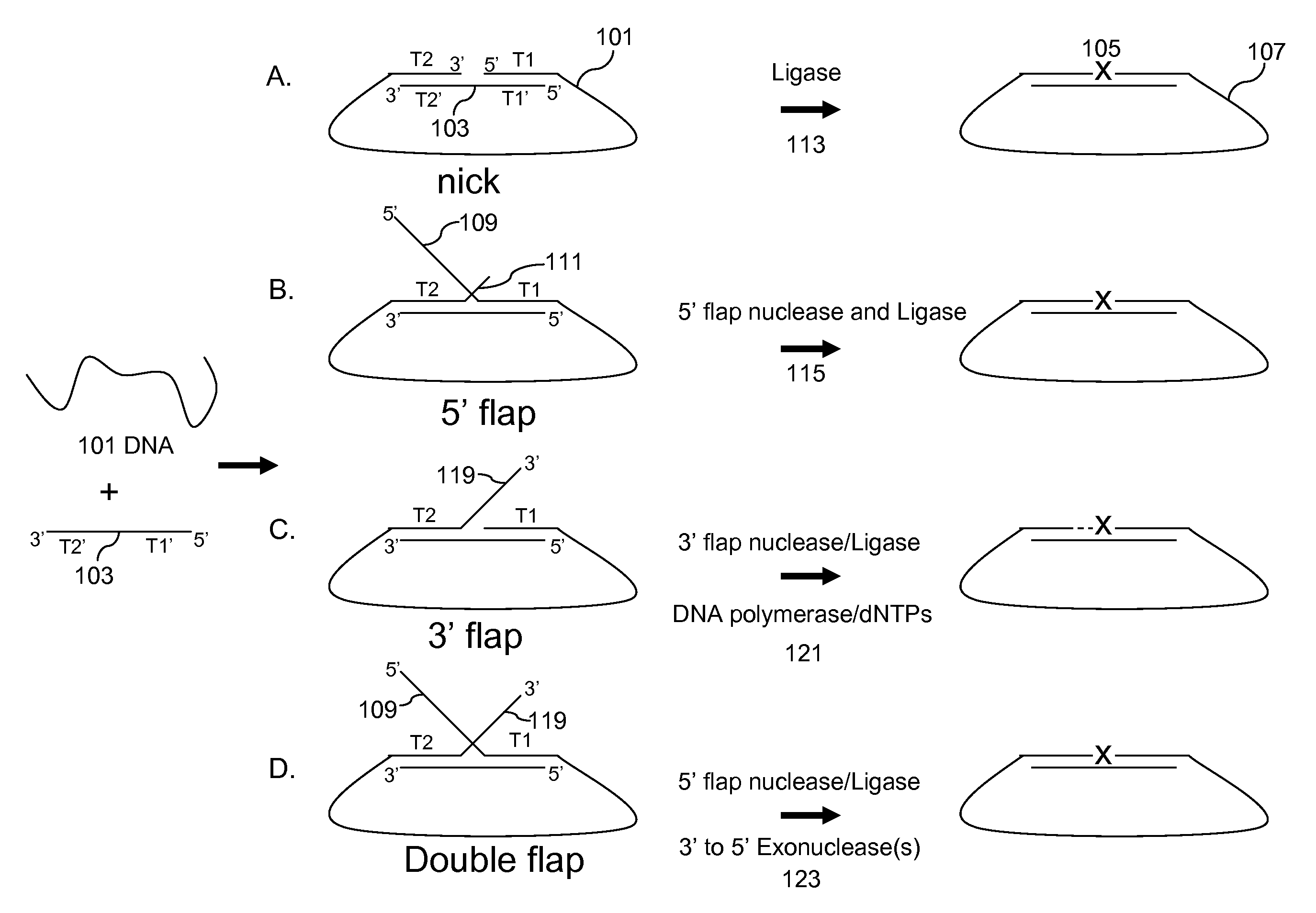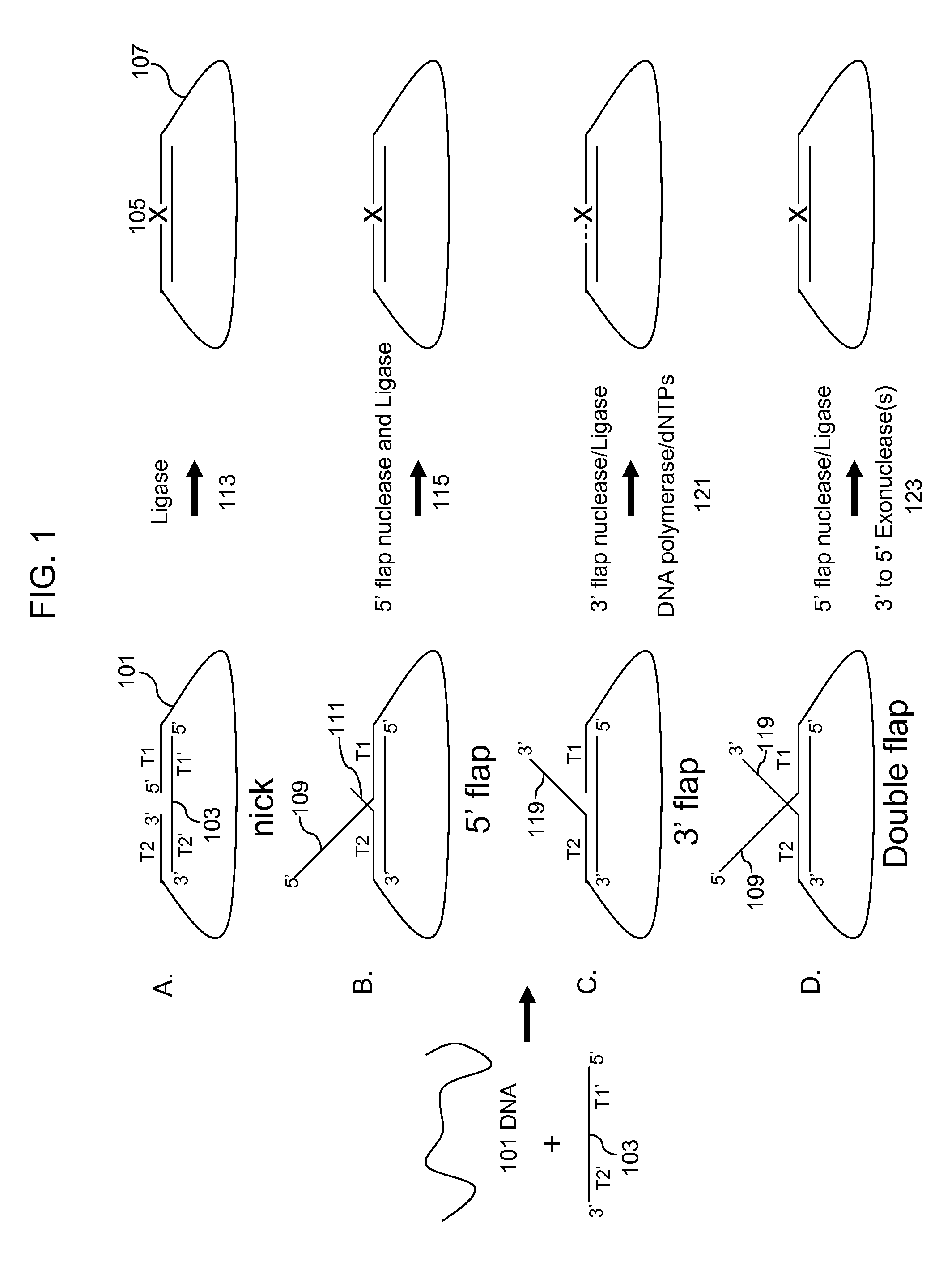Multiplex targeted amplification using flap nuclease
a targeted amplification and multi-target technology, applied in the field of multi-targeted amplification using flap nuclease, can solve the problems of poor sensitivity and specificity, unfavorable amplification of some templates, and unfavorable amplification of other templates
- Summary
- Abstract
- Description
- Claims
- Application Information
AI Technical Summary
Benefits of technology
Problems solved by technology
Method used
Image
Examples
example 1
[0151]Taq Polymerase and FEN1 specifically cleave the 5′ flap to create nicks for ligation. A control dU probe and corresponding targets with different flap length (0, 50 or 500 bases) were generated by PCR and purified. 50 amol of each were hybridized for about 3 hours in 30 mM Tris-HCl, pH 7.9, 15 mM MgCl2, 0.1% BSA by step-wise annealing (70° C. 40 min, 65° C. 40 min, 60° C. 40 min, 55° C. 20 min, 50° C. 20 min and then 4° C. hold after denaturation at 94° C. for 5 min. The reaction was desalted, the 5′ flap was removed and the targets were ligated using 40 U Taq ligase plus either 5 U Taq DNA polymerase, 0.25 μl hFEN1 or 0.25 μl Pfu FEN1 or none. After ligation, the reactions in the upper panel were purified by QIAQUICK™ spin columns (QIAGEN). All ligation products were treated with UDG, then amplified with common primers. An aliquot of each was separated by gel electrophoresis as shown in FIG. 4.
[0152]The expected position of migration of the expected product is shown by an arr...
example 2
[0153]FIG. 5 shows that a 3′ flap structure as shown in FIG. 3C can be removed by Sso XPF / PCNA mix (kindly provided by Dr. Malcolm White, UK) so that the common oligos can be ligated to the ends of the target and the target amplified by PCR. The reaction conditions were those used in Example 1 except different 3′ flap lengths were tested with 0.25 μl Sso XPF / PCNA, 40 U Taq DNA ligase, 2.5 U Taq DNA polymerase, 300 μM each of dATP and dCTP (the 5 bases next to the ligation site in the 3′ flap position) for the upper panel. The reactions in the lower panel had 0.25 μl Sso XPF / PCNA, 40 U Taq DNA ligase, 2.5 U Taq DNA polymerase, and varying amounts of dATP and dCTP as indicated. The template was either herring sperm DNA (HS), a target without 5′ or 3′ flaps (perfect), a target with a 3′ flap of 40 bases (3′+40) or a target with a 3′ flap of 500 bases (3′+500). The amplification product is not observed in the lane where there is no added dATP / dCTP and the 3′+500 lane. This is likely bec...
example 3
[0154]FIG. 6 Specific amplification of 355 targets simultaneously from normal control genomic DNA (Promega) and an FFPE human genomic DNA. Genomic DNA was cut with DdeI and 3 ng-100 ng was used in direct multiplex PCR with a dU probe pool (50 amol each) in 20 μl volume. To prepare the dU probe pool individual PCR reactions, in the presence of dUTP, were performed for each of 384 targets and successful products were obtained for 370 of the 384 (in subsequent studies PCR amplification conditions that allow successful amplification of the remaining 14 have been identified). 369 of the dU probes were used for capture (one was excluded because it contained a highly repetitive Alu sequence. The dU probes and digested DNA were mixed in a hybridization reaction with the common oligos first to allow hybridization of the dU probes, the targets and the oligos and to allow flap formation. The FEN1 and ligase were added after the hybridization step. These steps may also be combined if a thermost...
PUM
| Property | Measurement | Unit |
|---|---|---|
| temperature | aaaaa | aaaaa |
| temperature | aaaaa | aaaaa |
| temperatures | aaaaa | aaaaa |
Abstract
Description
Claims
Application Information
 Login to View More
Login to View More - R&D
- Intellectual Property
- Life Sciences
- Materials
- Tech Scout
- Unparalleled Data Quality
- Higher Quality Content
- 60% Fewer Hallucinations
Browse by: Latest US Patents, China's latest patents, Technical Efficacy Thesaurus, Application Domain, Technology Topic, Popular Technical Reports.
© 2025 PatSnap. All rights reserved.Legal|Privacy policy|Modern Slavery Act Transparency Statement|Sitemap|About US| Contact US: help@patsnap.com



